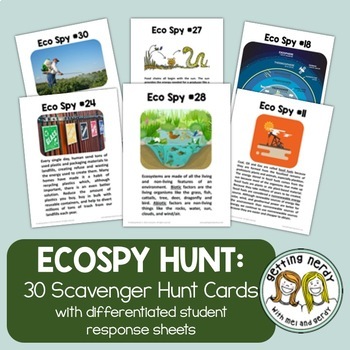Ecology Scavenger Hunt Review Activity
- Zip
- Google Apps™

What educators are saying
Description
Explore ecology as an Eco-Spy as you participate in this fun scavenger hunt activity that covers biomes, energy pyramids, food webs and food chains, symbiotic relationships (mutualism, parasitism, commensalism), succession, invasive species, current events like honey bee hive collapse and more!
WHAT'S INCLUDED in this 1-2 DAY LESSON:
• Differentiated NON-EDITABLE PDF versions of student response sheets in both standard and INB formatted pages
• 30 NON-EDITABLE Ecology Eco-Spy Fact Cards
• Answer keys for all student response sheets
• DIGITAL GOOGLE CLASSROOM links to all items listed above which can be easily converted to Microsoft School with directions provided or altered to fit your school’s personal learning management system
STUDENTS WILL:
• Move from card to card as they try to find the answers to each Eco-Spy card
THIS LESSON IS ALSO INCLUDED IN OUR:
- Ecology Bundled Unit which includes 7-9 weeks worth of materials in our 260+ slide PowerPoint and 100+ pages of handouts!
YOU MAY ALSO LIKE OUR:
- Ecology Think Tickets: Task Cards for Science Exploration
- Ecology Interactive Notebook Activities
Click this link to find out how this lesson fits with your NGSS, TEKS or GSE Science Classroom
Getting Nerdy's Terms of Use (TOU):
- Purchase of the product is for single classroom use by the purchaser only. It is a violation for individuals, schools, and districts to redistribute, edit, sell, or post this item on the Internet or to other individuals. Disregarding the copyright is a violation of the Digital Millennium Copyright Act and subject to legal action.
-By purchasing this product you acknowledge that you have read and understood the Terms of Use.
Ecology Eco-Spy Review by © 2012-present Getting Nerdy, LLC





